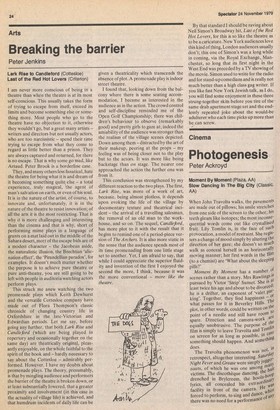Breaking the barrier
Peter Jenkins
Lark Rise to Candleford (Cottesloe) Last of the Red Hot Lovers (Criterion) I am never more conscious of being in a theatre than when the theatre is at its most self-conscious. This usually takes the form of trying to escape from itself, exceed its limits and become something else or something more. Most people who go to the theatre have no objection to it, otherwise they wouldn't go, but a great many artists — writers and directors but not usually actors, who are too narcissistic — spend their time trying to escape from what they come to regard as little better than a prison. They are always captured and returned, for there is no escape. That is why some go mad, like Artaud. Peter Brook is a borderline case.
They, and many others less fanatical, hate the theatre for being what it is and dream of it becoming something quite else — a total experience, truly magical, the agent of man's salvation on earth, or even of his soul. It is in the nature of the artist, of course, to innovate and, unfortunately, it is in the nature of the theatre to resist innovation; of all the arts it is the most restricting. That is why it is more challenging and interesting than the cinema and that is why, short of performing mime plays in a language of grunts on a mat laid out in the middle of the Sahara desert, most of the escape bids arc of a modest character — the Jacobean aside, the naturalistic illusion, the Brechtian 'alienation effect', the Pirandellian paradox', for examples. It doesn't much matter whether the purpose is to achieve pure theatre or pure anti-theatre, you are still going to be left with people in auditoria watching actors perform plays.
This struck me anew watching the two promenade plays which Keith Dewhurst and the versatile Cottesloe company have made out of Flora Thompson's classic chronicle of changing country life in Oxfordshire in the late-Victorian and Edwardian periods. Let me say, before going any further, that both Lark Rise and Candle ford (which are being played in repertory and occasionally together on the same day) are theatrically original, pleasantly enjoyable, on the whole faithful to the spirit of the book and — hardly necessary to say about the Cottesloe — admirably performed. However, I have my doubts about promenade plays. The theory, presumably, is that by mingling audience and performers the barrier of the theatre is broken down, or at least substantially lowered, that a greater proximity and involvement (in this case in the actuality of village life). is achieved, and that humdrum incidents of daily life can be given a theatricality which transcends the absence of plot. A promenade play is indoor street theatre.
I found that, looking down from the balcony where there is some seating accommodation, I became as interested in the audience as in the action. The crowd control and self-discipline reminded me of the Open Golf Championship; there was children's behaviour to observe (remarkably good) and pretty girls to gaze at; indeed the amiability of the audience was stronger than the realism of the village scenes depicted. Down among them distracted by the art of their makeup, peering at the props — my feeling was of being closer not to the play but to the actors. It was more like being backstage than on stage. The nearer one approached the action the further one was from it.
This conclusion was strengthened by my different reaction to the two plays. The first, Lark Rise, was more of a work of art, because, being almost plotless, it depends upon evoking the life of the village by documentary texture and theatrical incident — the arrival of a travelling salesman, the removal of an old man to the workhouse, and so on. The sequel, Candleford, has more plot to it with the result that it begins to remind one of a period-piece version of The Archers. It is also more static in the sense that the audience spends most of its time promenading from one little stage set to another. Yet, I am afraid to say, that while I could appreciate the superior fluidity and invention of the first I enjoyed the second the more, I think, because it was the more conventional — more like the theatre. By that standard I should be raving about Neil Simon's Broadway hit, Last of the Red Hot Lovers, for this is so like the theatre as to be a caricature. New York audiences love this kind of thing, London audiences usually don't; this one of Simon's was a long while in coming, via the Royal Exchange, Manchester, so long that its first night in the West End was preceded by a TV showing of the movie. Simon used to write for the radio and for stand-up comedians and is really not much better than a high class gag writer. If you like fast New York Jewish talk, as I do, you will find some enjoyment in these three strung-together skits before you tire of the same drab apartment stage set and the endlessly repeated joke about the would-be adulterer who each time picks up more than he can screw.


































 Previous page
Previous page